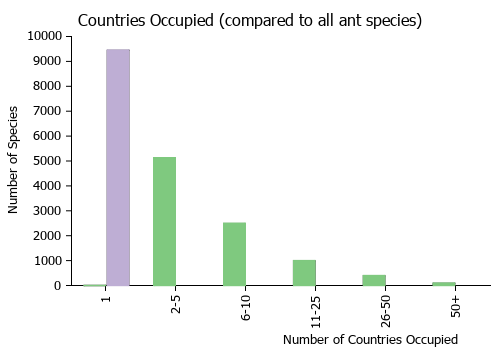Epopostruma wardi
| Epopostruma wardi | |
|---|---|

| |
| Scientific classification | |
| Kingdom: | Animalia |
| Phylum: | Arthropoda |
| Class: | Insecta |
| Order: | Hymenoptera |
| Family: | Formicidae |
| Subfamily: | Myrmicinae |
| Tribe: | Attini |
| Genus: | Epopostruma |
| Species: | E. wardi |
| Binomial name | |
| Epopostruma wardi Shattuck, 2000 | |
Habitats where this species has been encountered include dry sclerophyll, heavy swampy sclerophyll, wet sclerophyll on a steep slope with grassland and gums, wet sclerophyll on a steep slope and a plateau. Collections situations include leaf litter, in a lump of mossy soil at base of a eucalypt, at honey bait on scribbly gum, foraging on Angophora 10 feet above the ground and under rocks. It is known to lie motionless when disturbed.
Identification
Epopostruma wardi can be recognised by the distinctive head shape and the bispinose lateral postpetiolar margins together with having the area immediately above the eye rounded and the the posterolateral margin of postpetiole (immediately anterior of the gaster) flat to weakly concave rather than strongly concave.
Keys including this Species
Distribution
Latitudinal Distribution Pattern
Latitudinal Range: -29.25° to -35.26667023°.
| North Temperate |
North Subtropical |
Tropical | South Subtropical |
South Temperate |
- Source: AntMaps
Distribution based on Regional Taxon Lists
Australasian Region: Australia (type locality).
Distribution based on AntMaps
Distribution based on AntWeb specimens
Check data from AntWeb
Countries Occupied
| Number of countries occupied by this species based on AntWiki Regional Taxon Lists. In general, fewer countries occupied indicates a narrower range, while more countries indicates a more widespread species. |

|
Estimated Abundance
| Relative abundance based on number of AntMaps records per species (this species within the purple bar). Fewer records (to the left) indicates a less abundant/encountered species while more records (to the right) indicates more abundant/encountered species. |

|
Biology
|
Castes
Nomenclature
The following information is derived from Barry Bolton's Online Catalogue of the Ants of the World.
- wardi. Epopostruma wardi Shattuck, in Bolton, 2000: 61, figs. 63, 75, 82, 83 (w.) AUSTRALIA.
Type Material
- Holotype, worker, Karuah, New South Wales, Australia, Lowery,B.B., ANIC32-015699, Australian National Insect Collection.
- Paratype, 12 workers, Karuah, New South Wales, Australia, Lowery,B.B., ANIC32-003758, Australian National Insect Collection.
- Paratype, 2 workers, Karuah, New South Wales, Australia, Museum of Comparative Zoology.
Unless otherwise noted the text for the remainder of this section is reported from the publication that includes the original description.
Description
Area immediately above the eye angular. Pronotal spines present, long. Posterior section of metanotum and dorsal surface of the propodeum forming a continuous surface. Posterior face of propodeum between bases of spines and propodeal lobes with very narrow flanges with start below the bases of the spines. Petiolar spines present, long. Anterior face of postpetiole similar in length to the dorsal face, the two faces joined by a broad convexity; sides of postpetiole expanded laterally in the form of distinct sharp teeth or spines; their lateral margins strongly concave; posterolateral margin (immediately anterior of gaster) flat to weakly concave. Dorsum of petiole, postpetiole and gaster with numerous long, erect hairs, the majority bend near their tips. First gastral tergite smooth, the area immediately behind attachment with gaster with very short rugae. Body colour yellow-red, head, appendages and gaster sometimes slightly lighter, dorsum of head sometimes with a small infuscated spot.
Measurements
Holotype worker. TL 5.1, HL 1.24, HW 1.33, CI 107, MandL 0.56, MandI 45, SL 0.66, SI 50, PronW 0.74, ML 1.25.
References
- Shattuck, S. O. 2000. Genus Colobostruma. Genus Mesostruma. Genus Epopostruma. Pp. 31-67 in: Bolton, B. The ant tribe Dacetini. Mem. Am. Entomol. Inst. 65: 1-1028 (page 63, worker, queen described)
References based on Global Ant Biodiversity Informatics
- Bolton, B. 2000. The Ant Tribe Dacetini. Memoirs of the American Entomological Institute 65


